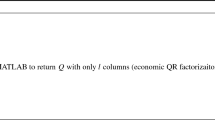Abstract
An algorithm called VPAStab is given for the acceleration of convergence of a sequence of vectors. It combines a method of vector-Padé approximation with a successful technique for stabilisation. More generally, this algorithm is designed to find the fixed point of the generating function of the given sequence of vectors, analogously to the way in which ordinary Padé approximants can accelerate the convergence of a given scalar sequence. VPAStab is justified in the context of its application to the solution of a large sparse system of linear equations. The possible breakdowns of the algorithm are listed. Numerical experiments indicate that these breakdowns can be classified either as pivot-type (type L) or as ghost-type (type D).
Similar content being viewed by others
References
G.A. Baker Jr. and P.R. Graves-Morris, Padé Approximants (Cambridge Univ. Press, Cambridge, 1997).
C. Brezinski and M. Redivo-Zaglia, Breakdowns in the computation of orthogonal polynomials, in: Nonlinear Numerical Methods and Rational Approximation II, ed. A. Cuyt (Kluwer, Dordrecht, 1994) pp. 49–59.
C. Brezinski and M. Redivo-Zaglia, Look-ahead in BiCGStab and other product methods for linear systems, BIT 35 (1995) 169–201.
C. Brezinski and H. Sadok, Some vector sequence transformations with applications to systems of equations, Numer. Algorithms 3 (1992) 75–80.
C. Brezinski and H. Sadok, Lanczos-type algorithms for solving systems of linear equations, Appl. Numer. Math. 11 (1993) 443–473.
R. Fletcher, Conjugate gradient methods for indefinite systems, in: Numerical Analysis, Dundee, 1975, ed. G.A. Watson, Lecture Notes in Mathematics, Vol. 506 (Springer, Berlin, 1976) pp. 73–89.
R.W. Freund, M.H. Gutknecht and N. Nachtigal, An implementation of look-ahead Lanczos algorithm for non-Hermitian matrices, SIAM J. Sci. Comput. 14 (1993) 137–158.
G.H. Golub and H.A. van der Vorst, Closer to the solution: Iterative linear solvers, in: The State of the Art in Numerical Analysis, eds. I.S. Duff and G.A. Watson (Clarendon Press, Oxford, 1997) pp. 63–92.
W.B. Gragg, Matrix interpretations and applications of the continued fraction algorithm, Rocky Mountain J. Math. 4 (1974) 213–225.
P.R. Graves-Morris, Reliability of Lanczos-type product methods from perturbation theory, Reliable Comput. 6 (2000) 411–428.
P.R. Graves-Morris, The breakdowns of BiCGStab, Numer. Algorithms (2002) in press.
P.R. Graves-Morris and A. Salam, Avoiding breakdown in van der Vorst's method, Numer. Algorithms 21 (1999) 205–223.
A. Greenbaum, Estimating the attainable accuracy of recursively computed residual methods, SIAM J. Matrix Anal. Appl. 18 (1997) 535–551.
M.H. Gutknecht, Variants of BiCGStab for matrices with complex spectrum, SIAM J. Sci. Comput. 14 (1993) 1020–1033.
M.H. Gutknecht, Lanczos-type solvers for non-symmetric linear systems of equations, Acta Numer. 6 (1997) 271–397.
M.H. Gutknecht and K.J. Ressel, Look-ahead procedures for Lanczos-type product methods based on three-term Lanczos recurrences, SIAM J. Matrix Anal. Appl. 21 (2000) 1051–1078.
M.H. Gutknecht and Z. Strakoš, Accuracy of two three-term and three two-term recurrences for Krylov space solvers, SIAM J. Matrix Anal. Appl. 22 (2000) 213–229.
W.D. Joubert, Lanczos methods for the solution of non-symmetric systems of linear equations, SIAM J. Matrix Anal. Appl. 13 (1992) 926–943.
C. Lanczos, Solution of systems of linear equations by minimised iterations, J. Res. Nat. Bureau Standarnds 49 (1952) 33–53.
MATLAB 6.0 (MathWorks, Natick, MA, USA).
Y. Saad, Preconditioning techniques for non-symmetric and indefinite linear systems, J. Comput. Appl. Math. 24 (1988) 89–105.
G.L.G. Sleijpen and D.R. Fokkema, BiCGstab(l) for linear equations involving unsymmetric matrices with complex spectrum, Electronic Trans. Numer. Anal. 1 (1993) 11–32.
G.L.G. Sleijpen and H.A. van der Vorst, Maintaining convergence properties of BiCGStab methods in finite precision arithmetic, Numer. Algorithms 10 (1995) 203–223.
G.L.G. Sleijpen and H.A. van der Vorst, Reliable updated residuals in hybrid Bi-CG methods, Computing 56 (1996) 141–163.
H.A. van der Vorst, Bi-CGStab: A fast and smoothly convergent variant of Bi-CG for the solution of non-symmetric linear systems, SIAM J. Sci. Statist. Comput. 13 (1992) 631-644.
Author information
Authors and Affiliations
Rights and permissions
About this article
Cite this article
Graves-Morris, P. VPAStab: Stabilised Vector-Padé Approximation with Application to Linear Systems. Numerical Algorithms 33, 293–304 (2003). https://doi.org/10.1023/A:1025532525878
Issue Date:
DOI: https://doi.org/10.1023/A:1025532525878




